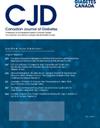Glucagon-like Peptide-1 Receptor Agonist Use in Hospital: A Multicentre Observational Study
IF 2.6
4区 医学
Q3 ENDOCRINOLOGY & METABOLISM
引用次数: 0
Abstract
Background
Glucagon-like peptide-1 receptor agonists (GLP-1RAs) are effective medications for type 2 diabetes mellitus (T2DM) and obesity, yet their uptake among individuals most likely to benefit has been slow.
Methods
We conducted a cross-sectional analysis of medication exposure in adults hospitalized at 16 hospitals in Ontario, Canada, between 2015 and 2022. We estimated the proportions of those with T2DM, obesity, and cardiovascular disease. We identified the frequency of GLP-1RA use and conducted multivariable logistic regression to identify factors associated with their use.
Results
Across 1,278,863 hospitalizations, 396,084 (31%) patients had T2DM and approximately 327,844 (26%) had obesity. GLP-1RA use (n=1,274) was low among those with a diagnosis of T2DM (0.3%) or obesity (0.7%), despite a high prevalence of cardiovascular disease (36%). In contrast, the use of diabetes medications lacking cardiovascular benefit was high during inpatient hospitalizations related to diabetes: 60% (n=236,612) received insulin and 14% (n=54,885) received a sulfonylurea. Apart from T2DM (odds ratio [OR]=29.6, 95% confidence interval [CI] 23.5 to 37.2), characteristics associated with greater odds of receiving a GLP-1RA were seen in those 50 to 70 years of age (OR=1.71, 95% CI 1.38 to 2.11) compared with those <50 years of age, glycated hemoglobin >9% (OR=1.83, 95% CI 1.36 to 2.47) compared with <6.5%, and highest income quintile (OR=1.73, 95% CI 1.45 to 2.07) compared with lowest income quintile.
Conclusion
Knowledge translation interventions are needed to address the low adoption of GLP-1RAs among hospitalized patients with T2DM and obesity, who are the most likely to benefit from this treatment.
医院中胰高血糖素样肽 1 受体激动剂的使用:一项多中心观察研究。
简介:胰高血糖素样肽 1 受体激动剂(GLP-1RA)是治疗 2 型糖尿病(T2DM)和肥胖症的有效药物,但其在最有可能受益的患者中的使用率却很低:我们对 2015 年至 2022 年期间在加拿大安大略省 16 家医院住院的成人用药情况进行了横断面分析。我们估计了患有 T2DM、肥胖症和心血管疾病的比例。我们确定了GLP-1RA的使用频率,并进行了多变量逻辑回归以确定与使用GLP-1RA相关的因素:在 1,278,863 例住院患者中,396,084 人(31%)患有 T2DM,约 327,844 人(26%)患有肥胖症。尽管心血管疾病的发病率较高(36%),但在诊断为 T2DM(0.3%)或肥胖症(0.7%)的患者中,GLP-1RA 的使用率较低(n=1,274)。与此相反,在与糖尿病有关的住院患者中,使用缺乏心血管益处的糖尿病药物的比例很高:60%(n=236,612)的患者使用了胰岛素,14%(n=54,885)的患者使用了磺脲类药物。除T2DM(OR=29.6,95% CI 23.5,37.2)外,与接受GLP-1RA几率更大相关的特征有:年龄50-70岁(OR=1.71,95% CI 1.38,2.11)与年龄<50岁相比,血红蛋白A1C>9%(OR=1.83,95% CI 1.36,2.47)与<6.5%相比,最高收入五分位数(OR=1.73,95% CI 1.45,2.07)与最低收入五分位数相比:需要采取知识转化干预措施,以解决T2DM和肥胖症住院患者中GLP-1RA使用率低的问题,因为这些患者最有可能从中受益。
本文章由计算机程序翻译,如有差异,请以英文原文为准。
求助全文
约1分钟内获得全文
求助全文
来源期刊

Canadian Journal of Diabetes
ENDOCRINOLOGY & METABOLISM-
CiteScore
4.80
自引率
4.00%
发文量
130
审稿时长
54 days
期刊介绍:
The Canadian Journal of Diabetes is Canada''s only diabetes-oriented, peer-reviewed, interdisciplinary journal for diabetes health-care professionals.
Published bimonthly, the Canadian Journal of Diabetes contains original articles; reviews; case reports; shorter articles such as Perspectives in Practice, Practical Diabetes and Innovations in Diabetes Care; Diabetes Dilemmas and Letters to the Editor.
 求助内容:
求助内容: 应助结果提醒方式:
应助结果提醒方式:


